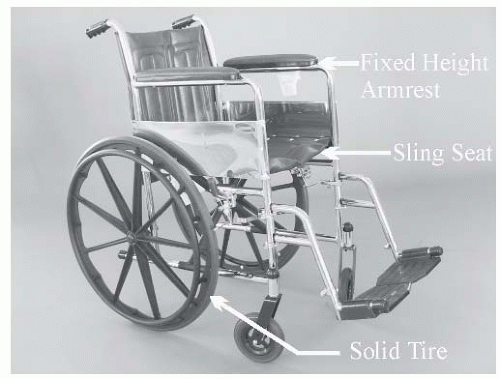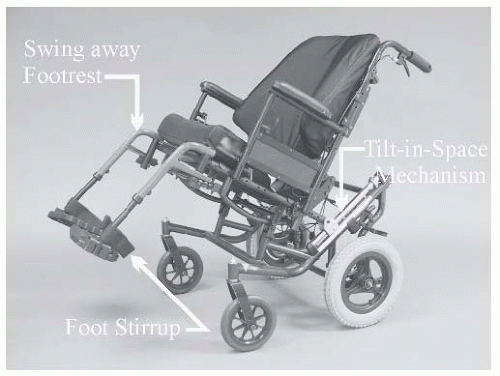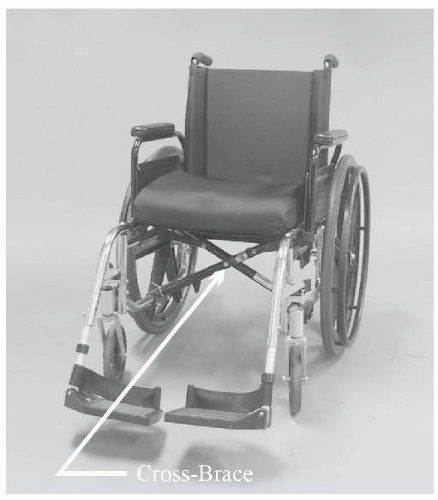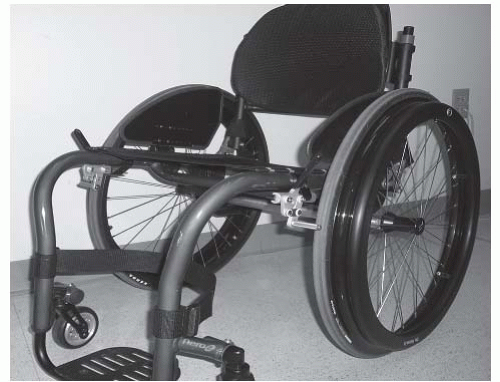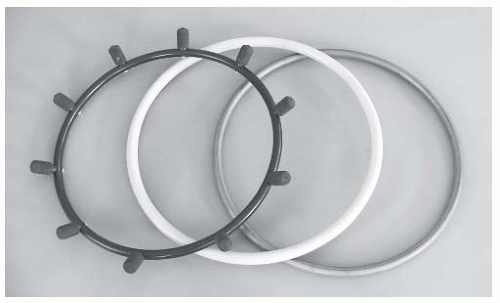Team Approach
The complexity of wheelchair and seating components combined with the nuances of individuals and various disease processes make it virtually impossible for a single clinician to act independently when prescribing assistive technology for mobility. For this reason, it is important to involve an interdis-ciplinary team in the decision-making process (
7). The most important team member is the patient. The opinions and desires of the patient are critical to a successful fitting but must be assessed in terms of their level of knowledge and insight. Some patients have been using a wheelchair for years and know exactly what they are looking for. For these individuals, team members act to provide unbiased information. Alternatively, a novice patient may have little knowledge of what is available and the trade-offs of each decision. For this individual, the team will need to be more directive. The family and caregiver should also provide input, as they will be the next most affected by the choice of wheelchair.
The assessment team can consist of a variety of rehabilitation professionals (
Table 78-1). Currently, Medicare and the majority of private insurance companies require a face-to-face physician assessment focused on mobility before providing a wheelchair. Given the training on function and mobility, a physiatrist can be the most appropriate physician to complete this assessment. Often an occupational or physical therapist working with the physician will conduct an evaluation. Ideally, the therapist will be certified by The Rehabilitation Engineering and Assistive Technology Society of North America (RESNA) as an assistive technology practitioner (ATP). Other professionals who can be certified and may be part of the team include a rehabilitation engineer, an Assistive Technology Supplier (ATS), or Certified Rehabilitation Technology Supplier (CRTS, National Association of Rehabilitation Technology Suppliers).
Those involved in the wheelchair selection process should have knowledge about the technology available on the market. Magazine articles and commercial database sources such as ABLEDATA (http://www.abledata.com/) and SpinLife (www.spinlife.com) are good places to research devices or to direct patients who want to educate themselves. (As with any medical advice, patients should be cautioned that information gathered from TV, internet, magazines, etc., should be confirmed with their physician, therapist, or technology supplier.) People choose their seating and mobility devices based on the features available that will facilitate activities or address needs (
8); therefore, it is important to be aware of the user’s preferences and the features of various devices.
Patient History
The interview process is largely the same as any standard history conducted with a patient. The necessary information such as age, past medical history, and current medical diagnosis needs to be gathered. The assessment process involves obtaining critical information about the user and his or her environment, family support, and past use of assistive technology. It is essential to determine if the individual’s physical impairment is changing rapidly or is stable. It is important to establish the diagnosis that requires the wheelchair and to assure that there are no ongoing medical problems or complications that can affect the wheelchair prescription and the patient’s health.
To properly specify a wheelchair, it is important to understand both the intentions and the abilities of the user (
9). It is essential that the clinician takes into account the characteristics
of the intended user and potential caregivers to ensure that the wheelchair will be accepted and used by the user. Access to a range of heights might be important to reach objects in the home and other environments. To support vocational needs, specific requirements may exist for mobility within a laboratory, operating room, courtroom, or machine shop. Leisure activities, pursued in such places as community centers, restaurants, movie theaters, and recreational environments, often place the most demands on the wheelchair. For some users, many of the desired tasks may be accomplished simply and with existing off-the-shelf technology. Others will require custom products, and some will not be able to achieve all of their goals with existing technology.
Additional necessary information includes type of insurance, physical capabilities and if the individual is able to transport a wheelchair. Also, if the patient has been using a chair, historical information about his or her current chair should be addressed, including problems he or she may be having. The wheelchair model chosen should also be compatible with the user’s public and private transportation needs (such as a bus, train, car, van, or airplane) and home/Activities of Daily Living (ADL) environment.
The surface conditions may impose restrictions on the type of wheelchair that is most appropriate. The regularity of the surface and its firmness and stability are important in determining the tire size, drive wheel location, and wheel diameter. The performance of the wheelchair is often dictated by the need to negotiate grades, as well as height transitions, such as thresholds and curbs. The clearance widths in the environment will determine the overall dimensions of the wheelchair. A scooter may not fit around a corner in an average person’s home but might perform well outdoors on a sidewalk. The need to be able to operate in snow, rain, and other weather conditions are important considerations as well.
Physical Examination
With an understanding of the individual’s need or desire to perform different activities, the next step is examining the user. The history likely provided significant insight related to his or her physical abilities. To verify this, a physical examination should focus on aspects of the patient that will help (a) justify the wheelchair and seating system, (b) determine the most appropriate wheelchair and seating system, and (c) assure that medical issues are appropriately addressed. Based on the interview of the patient, it may be possible to omit some portions of the examination listed below.
Often individuals require a wheelchair because of cardiopulmonary disease. For these individuals it is important to document a heart and lung examination. Attention should be paid to dyspnea on exertion and changes in vital signs with activity. These findings can be used to justify a power wheelchair, as the energy cost of wheelchair propulsion is not less than walking (
10). Other common reasons for requiring a wheelchair are musculoskeletal and neurologic deficits. The clinician should document the neurologic and musculoskeletal deficits in a methodical fashion. In a patient with a stroke, for example, an examination to check for neglect or visual field deficit is important because it will impact on the ability to independently drive a chair.
Obvious examination items include strength and range of motion. For individuals with chronic arthritis problems, the examination should document the painful, swollen, or malaligned joints. When no strength deficit is seen, it is important to document issues with coordination, tone, and proprioception. For example, a study by Fay et al. found that many individuals with multiple sclerosis were unable to effectively propel manual wheelchairs due to increased tone and decreased coordination (
11). Participants showed an inability to maintain a speed comparable to community walking speed (1 m/s). This type of finding can provide justification for the device selected.
While completing the examination, the physician should be thinking about how the individual will control the wheelchair. If there is poor hand coordination, head control or switch control may be needed. In certain cases, a foot joystick may be possible.
For some individuals, the examination and history will not necessarily establish a clear need for a wheelchair. In these cases, it is important to consider alternative options that meet the individual’s functional needs.
It is important to establish how long the individual will be using the chair. If from the history and examination it is determined that the deficit will be transient, then a rental chair may be appropriate. Medicare will rent chairs for their beneficiaries. This is a good option if the duration of use will be short and the device does not need to be customized. If during the history and physical examination medical issues that require intervention are identified, it may be appropriate to delay wheelchair prescription so that changes in the patient status do not necessitate changes in the prescription. In such case a rental may provide short-term mobility.
Stability can be assessed by observing the individual in the current wheelchair or by asking him or her to sit unsupported on a mat table. Ask the patient to perform simple reaching tasks to determine the lateral and forward stability of the trunk, hand and arm strength, and hand fine motor skills. The presence of kyphosis, scoliosis, or other fixed deformities should be determined. Critical point to evaluate is hip and knee range of motion because contractures may need to be accommodated. Poor stability usually indicates the need for special attention to seating and position. Appropriate seating can enhance reach and stability, thus improving the performance of manual activities from the wheelchair. It is well known that various groups of wheelchair users, such as individuals with tetraplegia and cerebral palsy, will develop kyphosis or scoliosis over time (
12).
What is less well known is whether spinal deformities can be prevented with appropriate seating. Even if prevention is not a goal, accommodation is needed for comfortable seating.
Finally, a thorough check of the individual’s skin is important. This may not be needed for individuals with cardiopulmonary disease, but it is essential for individuals with neurologic deficits or those with previous history of pressure sores. The examination should include not only the buttocks but also the feet and calves, which can be affected by pressure against a leg rest. Attention should be paid to bony prominences and previous scars. This examination will help with cushion selection and wheelchair setup. Large, previously untreated ulcers are sometimes discovered, ultimately leading to treatment before seating plans can be implemented.
For many people a few simple measurements can be used to determine the proper dimensions for a wheelchair (
13). Body measurements are typically made with the consumer in the seated position. Probably the most obvious body measurements are the consumer’s height and weight. The consumer’s weight is critical to obtaining a wheelchair that is sufficiently strong as many wheelchairs are only rated to hold up to 113 kg (250 lb). The height of the wheelchair user provides information about the person’s size and can be used to check the final wheelchair measurements. For example, the sum of the sitting height, sitting depth, and lower-leg length should be close to the person’s supine height. Additional measurements and definitions are used when specialized seating and postural support systems are required. These measurements may be completed by any one of the team members.
Documentation
Providing appropriate and quality wheelchairs requires well organized and often extensive documentation. At the very least, a prescription and various insurance forms must be provided. For more expensive and complex interventions, a letter of medical necessity (LMN) is required.
Table 78-2 list Medicare recommended assessment findings for power wheelchair provision. This letter can consist of two components: a cover letter and the “client/patient evaluation and intake form.” The cover letter summarizes the person’s disability, problems with existing equipment or method of mobility, evaluation procedures, conclusions, explanation of why lower-cost alternatives will not work, risks of not providing the equipment, and a line-item justification for each of the various components being recommended. The “client/patient evaluation and intake form” guides the evaluation process and captures in-depth information of the evaluation findings required to support recommendations of the appropriate seating and mobility interventions. Often, a part of this exam will be completed by an occupational or physical therapist. The therapist will perform clinical trials and simulations, which allow the patient to try many different devices.
The prescription process should include a home assessment to make sure the device selected will work in the home environment. A home assessment conducted by the supplier is required by Medicare. This requirement highlights the importance of working with qualified suppliers such as those with the ATS credentials. If a home visit is conducted, documentation of the visit should be included in the LMN.
In order for any health insurance provider to approve coverage for a wheelchair and seating system, the practitioner must establish and document medical necessity. Each funding source may have its own definition of “medically necessary,” however; in general, when it comes to wheelchairs, it is necessary to accommodate or replace a malfunctioning body part (i.e., paralysis or weakness of the lower extremities) or to reduce or manage disability. Many funding sources also require
the recommended intervention to be the least costly, reasonable alternative. Therefore, as part of an evaluation, it is helpful to document that lower-cost alternatives have been tried and were unsuccessful, and to cite specific reasons for the higher-cost choice. It is also helpful to document the potential outcomes if the person is not provided with the equipment. Examples of these risks include falls and fractures, development of pressure sores, joint contractures and musculoskeletal deformities, increased pain and discomfort, loss of function, and ultimately being more restricted to a bed or chair.
The final letter is reviewed by both the therapist and physician and cosigned. It is not appropriate for a physician or a therapist to sign the LMN for a client/patient if he or she has not evaluated the person for the device prescribed.

